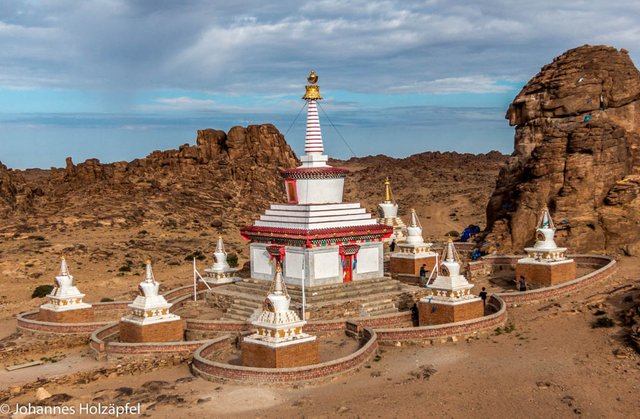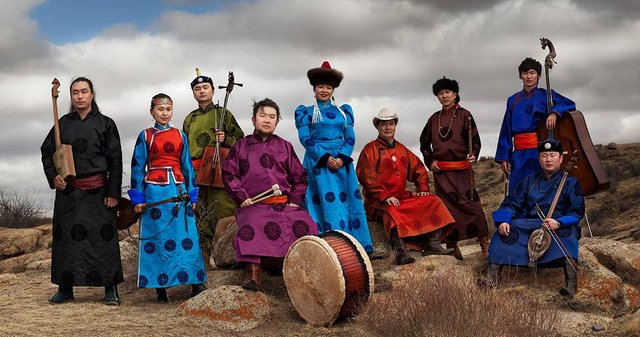WORLD MUSIC TRADITIONS - MONGOLIA, The Big Sky Country
If there’s a place that deserves the title “Big Sky Country,” it would be landlocked Mongolia, tucked between China to the south and Russia to the north. Its open grassland landscapes— called steppe—and the great Gobi Desert, plus most days being cloudless, give visitors a feeling of great openness. With little arable land, sparse rainfall, and a short growing season, the Mongolians long ago learned to co-exist with their harsh climate, hot in the summer and extremely cold and windy in the winter. Originally a nomadic people dependent on their beloved horses, today only 30 per cent of the population of only 2.9 million maintain this life style. In spite of this tiny population, Mongolia is a country of great diversity, of numerous if little-known ethnic groups, and of religious complexity. While many Mongolians continue to practice their ancient form of shamanism—shamans being spe- cialists in “traveling” to the land of the spirits—they long ago also embraced the Tibetan form of Buddhism, as seen in magnificent temples in urban areas.

Originally, much of Mongolia’s music had spiritual and religious significance, because music was often considered a form of communication between the worlds of humans and spirits. Under communism, however, most musical traditions were secularized and put on the stage. Music that had been—and mostly continues to be—passed down orally has also been harnessed by the European-style music conservatories. It is overtone singing that has brought Mongolian music to world attention. While overtone singing is both important and distinctive, the country’s most typical form of music is actually the urtïn duu, the “long songs” accompanied by Mongolia’s most distinctive instrument, a trapezoid-bodied, long- necked bowed lute called the morin khuur. Where the overtone singing lacks lyrics, the long songs retell the culture’s great stories and history as well as describe the natural environment; some say that these “sing the landscape.”
It is not the instrument that attracts our attention—that is clearly a bowed lute— but rather the performer’s singing, if that is the right term.
Some listeners describe these sounds as unearthly and find them “haunting.” Some observers say it resembles whistling and wonder how such sounds are produced. Additionally many ask what might have inspired a culture to produce such sounds.
Traditional Mongolian life was and, for many, continues to be lived in nature and among one’s flocks of sheep and goats. Without horses, Mongolians would have no way to travel or herd their flocks, and thus it is not surprising that they would enshrine the horse on their principal bowed lute, the morin khuur which, because of the carved horse-head at the top is translated as “horse-head fiddle.” This long-necked fiddle, with two silk strings and a separate bow, is normally played by a seated male, with the body of the instrument resting on his knee and the neck resting against his shoulder.

The Mongolian term for this type of singing is khöömei (also romanized as höömii), while in English it is called throat-singing (a somewhat odd label, because all singing takes place in the throat) or overtone singing. What makes this singing so distinctive is the way in which the singer manipulates what are called overtones. Any tone or pitch, except perhaps one generated electronically, consists of a fundamental and a series of harmonics, called overtones or partials. The timbre of a given tone is determined by which overtones are emphasized—a function of how the fundamental was produced (e.g., by a double reed, a vibrating string, buzzing lips, etc.)—and by the relative weakness or strength of the various overtones. A tone in which the lower overtones are emphasized will likely sound “warm,” whereas one in which the upper overtones are more prominent will sound “bright,” “harsh,” or perhaps “hollow.”
In overtone singing, the performer—formerly only male, now female as well—produces, usually with significant pressure on the glottis (a part of the vocal cords), a fundamental and, by shaping the mouth cavity, brings out different patterns of overtones. A series of well- controlled, changing overtones produces an actual melody over a drone. Highly skilled singers can even produce both the lower melody and the overtone melody simultaneously, as heard in this track.
Cultural Considerations
Among “world music” enthusiasts little has garnered as much attention in recent years as “throat-singing,” also called “overtone singing.” While a similar form of singing found in the nearby Republic of Tuva has perhaps attracted a greater following in the West in recent years, Mongolian overtone singing is certainly just as striking. Singers in other areas of the world, including Altai, Khakassia, the Chukchi Peninsula, Tibet, Japan’s Hokkaido (now extinct), Sardinia in the Mediterranean as well as the Inuit of Alaska, practice various forms of overtone singing, but less prominently than in Mongolia. Few outsiders will have the opportunity to hear Mongolian overtone singing in its original context—performed in a yurt (round tent) with singers surrounded by family and friends. Nonetheless, many recordings of overtone singing exist, sometimes even combining it with various forms of art and popular music. American musician Bela Fleck, for example, has collaborated with Mongolian throat singer Kongar-Ol Ondar, and under the indirect influ- ence of German avant-garde composer Karlheinz Stockhausen, created an extended work titled Stimmung in 1968, which features overtone singing.
In Mongolia this unique style of singing is closely tied to the shamanistic/animistic beliefs still held by many Mongolians. The voice is meant to imitate the sounds of nature, attempting to duplicate the rich timbres of natural phenomena such as the swirling wind or rushing water. Mountains, rivers, and animals are believed to contain a spiritual energy that is manifested not only physically but sonically as well. Echoes reflected from a cliff, for example, are said to be infused with spiritual power. Overtone singers believe they can assimilate this power by recreating such sounds. Some speculate that overtone singing orig- inated from the efforts of herders to imitate animal sounds when trying to rescue newborn animals when unable to nurse or when rejected by the mother. Sometimes herders soothed or coaxed their animals with their overtone singing. From these functions it is believed that herders honed their abilities until this form of singing became part of the musical traditions of Mongolia.
For closing i will like to share a live performance of the most known mongolian group Huun‐Huur‐Tu:

🎶🎵Sharing my music all around the world! 🎵🎶
Spotify
Facebook
Steemit
Instagram
Hello! I read your articles. You are a good writer.
I signed up for you and hope you subscribe to me! @orshanec
I will vote for your articles. And you are for mine. A good day!
This post has received a 23.37 % upvote from @boomerang.
I upvoted your post.
Thank you.
@Yehey
Posted using https://Steeming.com condenser site.
Mangolia overtone music is quite extraordinary,i have heard it.Also its harsh condition is veet difficult still people r living it.have they some soecial music instrument too @nadabrahmasounds
You got a 9.89% upvote from @postpromoter courtesy of @nadabrahmasounds!
Want to promote your posts too? Check out the Steem Bot Tracker website for more info. If you would like to support the development of @postpromoter and the bot tracker please vote for @yabapmatt for witness!
congratulation your beautiful post is in trending...
Your post had been curated by the @buildawhale team and mentioned here:
https://steemit.com/curation/@buildawhale/buildawhale-curation-digest-09-17-18
Keep up the good work and original content, everyone appreciates it!